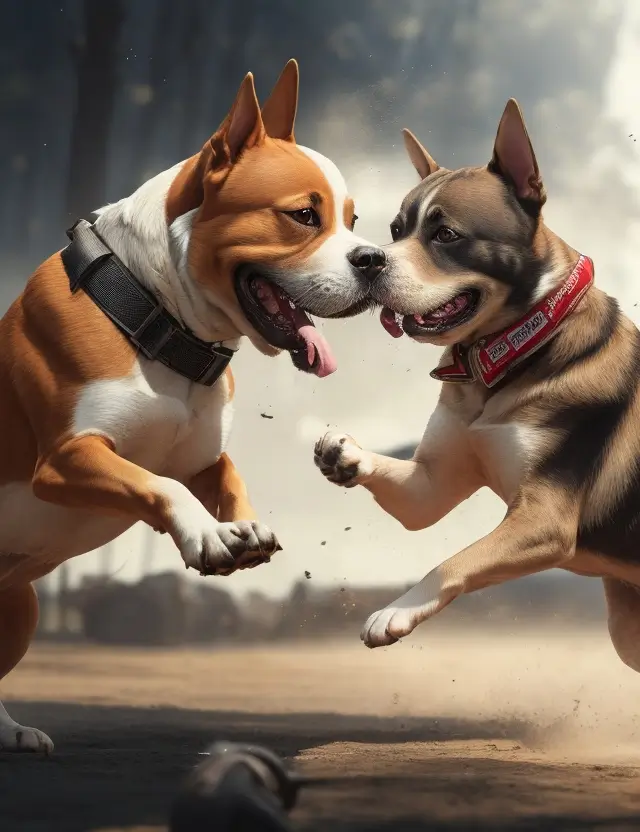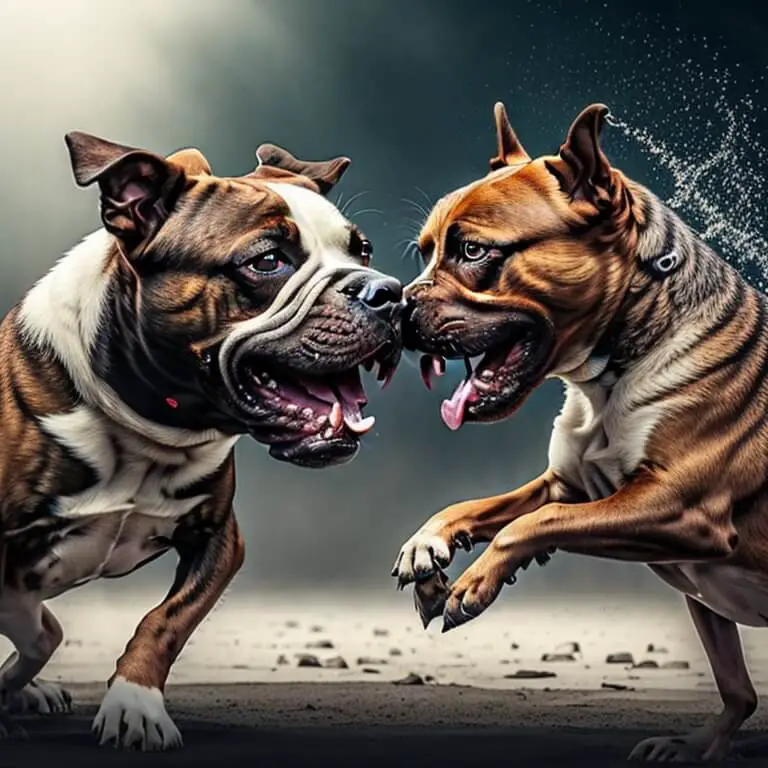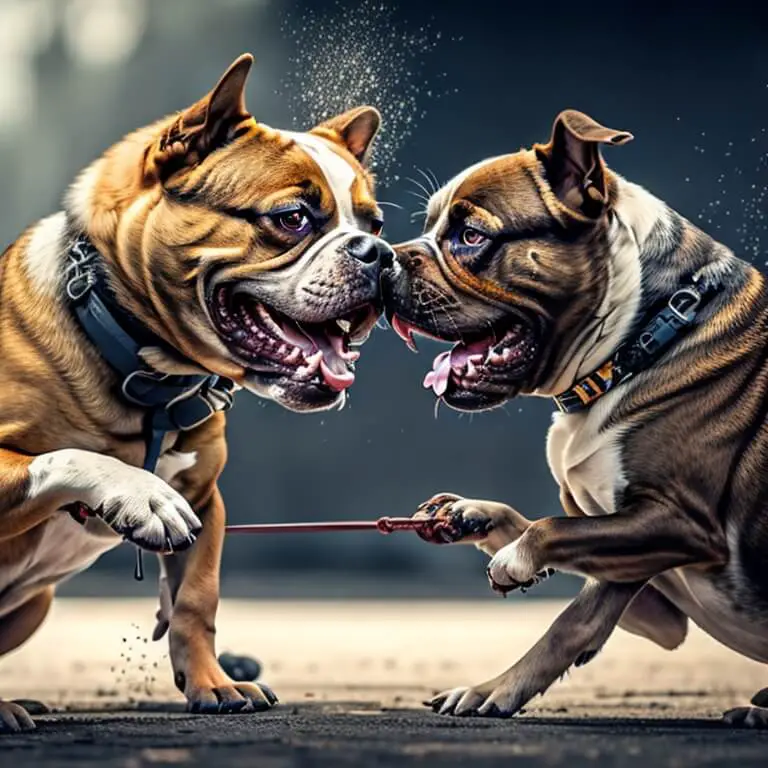“What is a bait dog?” when we ask the question, we delve into a dark and cruel aspect of animal cruelty. A bait dog is a canine that is used as a sacrificial object for other dogs to attack, primarily in the illegal and brutal world of dog fighting. This practice is not only inhumane but also a severe violation of animal welfare laws.

Understanding the concept of a bait dog is crucial, as it sheds light on the horrific realities many animals, particularly pit bulls, face. It is a subject that demands our attention, compassion, and action, as awareness and education are the first steps to eradicating such barbaric practices.
In this article, we will explore the world of bait dogs, the impact it has on them, and the broader implications it has on animal welfare and dog behavior. We will also discuss the role of animal rescue organizations, dog training methods, and legal consequences related to dog fighting and using bait dogs.
Why is Awareness Important?
Awareness is the cornerstone of change. By understanding the plight of bait dogs, we can:
- Advocate for stronger animal rights and animal welfare laws.
- Support animal rescue efforts to save and rehabilitate bait dogs.
- Promote responsible dog ownership and dog care to prevent such practices.
The Role of Education
Education empowers us to make informed and compassionate choices. It enables us to:
- Recognize the signs of dog abuse and dog fighting.
- Learn about dog training techniques and dog rehabilitation to help rescued bait dogs.
- Understand the importance of dog socialization and dog obedience training in preventing dog aggression and dog bites.

The Journey Ahead
This journey will be a revelation of the harsh realities and the transformative stories related to bait dogs. It will be a guide to understanding the importance of compassion, responsibility, and action in the world of dog ownership and animal welfare.
Let’s embark on this journey to shed light on the hidden and painful world of bait dogs, and let’s strive to make a difference in the lives of these innocent animals.
Understanding Dog Fighting
Dog fighting is a heinous and illegal activity where dogs are forced to fight one another for the amusement and financial gain of spectators. It is a world shrouded in secrecy, brutality, and blatant disregard for animal welfare and animal rights. In this clandestine world, bait dogs are the silent victims, suffering unimaginable cruelty and abuse.
The Illegality and Cruelty of Dog Fighting
Dog fighting is strictly prohibited by law due to its extreme cruelty and the severe harm it inflicts on the animals involved. It is a barbaric practice that subjects dogs to:
- Severe physical pain and injury
- Psychological trauma
- Premature death
Role of Bait Dogs in Dog Fighting Rings
Bait dogs are used as living punching bags for fighting dogs to hone their aggression and fighting skills. These dogs are often:
- Tied up or restrained
- Muzzled to prevent them from defending themselves
- Subjected to relentless attacks

The Victims
Most commonly, pit bulls and other strong, muscular breeds are chosen as fighting dogs, while smaller, weaker, or more submissive dogs are used as bait. The bait dogs endure immense suffering, often leading to severe injuries or death.
Impact on Dog Behavior and Psychology
The trauma experienced by bait dogs can lead to long-lasting behavioral and psychological issues, including:
- Dog aggression
- Fear and anxiety
- Difficulty in socialization
The Table of Suffering
| Impact on Bait Dogs | Consequence |
|---|---|
| Physical Injury | Lifelong pain and disability |
| Psychological Trauma | Behavioral issues and fearfulness |
| Death | Loss of innocent lives |
The Need for Action
Understanding dog fighting and the role of bait dogs is crucial for eradicating this cruel practice. By recognizing the signs of dog fighting and dog abuse, and by reporting suspicious activities, we can:
- Save innocent animals from suffering and death
- Bring the perpetrators to justice
- Promote animal welfare and animal rescue efforts
Let’s unite in our efforts to understand, expose, and eliminate dog fighting and to rescue and rehabilitate its countless victims, giving them a chance for a life filled with love, care, and happiness.
Identification of Bait Dogs
Identifying bait dogs is a crucial step in rescuing them from the horrific world of dog fighting and providing them with the care and rehabilitation they desperately need. Recognizing the signs and symptoms that a dog has been used as bait can help in the timely intervention and prevention of further abuse and cruelty.
Recognizing the Signs and Symptoms
Bait dogs exhibit several signs and symptoms due to the severe abuse and trauma they endure. Some of the common indicators include:
- Multiple bite wounds and scars, especially around the face, neck, and legs.
- Signs of malnutrition and neglect, such as emaciation and poor coat condition.
- Fearful and submissive behavior, particularly around other dogs.
- Evidence of being restrained or muzzled, such as marks or scars around the muzzle area.
Common Breeds Used as Bait Dogs
While any dog can be used as bait, certain breeds are more commonly victimized due to their perceived weakness or submissiveness. Pit bulls, ironically, are often chosen both as fighting dogs and as bait dogs, depending on their temperament and physical condition. Other commonly used breeds include:
- Small or frail dog breeds
- Older dogs
- Dogs with gentle and submissive temperaments
The Plight of Pit Bulls
Focusing on pit bulls, it is essential to understand the dual victimization they face. Many are forced into violent roles due to their strength and resilience, while others, deemed unfit for fighting, are used as bait. This breed, often misunderstood and misrepresented, bears the brunt of human cruelty in the world of illegal dog fighting.
Table of Common Signs in Bait Dogs
| Signs and Symptoms | Possible Indications |
|---|---|
| Multiple Bite Wounds | Recent attacks or fights |
| Malnutrition | Neglect and lack of care |
| Fearful Behavior | Psychological trauma |
| Restraint Marks | Being used as bait |
The Path to Intervention
Identifying bait dogs is not just about recognizing the signs; it’s about taking action. It’s about reporting suspicions, supporting animal rescue efforts, and advocating for stronger animal welfare laws. By doing so, we can play a pivotal role in saving these innocent animals from a life of pain and suffering and ensure that they receive the love, care, and respect they deserve.
Let’s be the voice for the voiceless and the protectors of the innocent. Let’s work together to identify, rescue, and rehabilitate bait dogs and to put an end to the cruel and illegal practice of dog fighting.
The Impact on Bait Dogs
The impact on bait dogs is profound and multifaceted, encompassing severe physical and psychological trauma. These innocent animals, subjected to unimaginable cruelty, bear the scars of their ordeal, both inside and out. Understanding the depth of their suffering is crucial in addressing their needs and advocating for their welfare.
Physical Trauma
Bait dogs endure extreme physical abuse, leading to a myriad of health issues and injuries. The brutality they face often results in:
- Severe wounds and lacerations
- Broken bones and internal injuries
- Infections and diseases due to lack of medical care
- Malnutrition and dehydration
Psychological Trauma
The psychological impact on bait dogs is equally devastating. The constant fear and stress leave them with deep emotional scars, manifesting as:
- Extreme fear and anxiety
- Aggression and trust issues
- Difficulty in forming bonds with humans and other animals
- Behavioral problems and neuroses
Long-term Effects
The long-term effects on bait dogs are a testament to the severity of their abuse. Many suffer from chronic health conditions, behavioral issues, and a diminished quality of life. Some of the lasting impacts include:
- Chronic pain and disability
- Behavioral disorders and emotional instability
- Reduced life expectancy due to the cumulative effects of trauma and neglect
Possibility of Rehabilitation
Despite the immense suffering bait dogs experience, there is hope. With proper care, medical attention, and behavioral therapy, many bait dogs can be rehabilitated and can lead fulfilling lives. Rehabilitation efforts focus on:
- Medical treatment and healing of physical wounds
- Behavioral therapy and dog training to address psychological trauma and behavioral issues
- Love, care, and a safe environment to rebuild trust and form bonds
Impact and Rehabilitation Table
| Impact on Bait Dogs | Rehabilitation Measures |
|---|---|
| Severe Physical Injuries | Medical Treatment and Care |
| Psychological Trauma | Behavioral Therapy and Training |
| Long-term Health Issues | Ongoing Veterinary Care and Monitoring |
| Behavioral Disorders | Consistent Training and Positive Reinforcement |
The Journey to Recovery
The journey to recovery for bait dogs is long and challenging, but with patience, love, and commitment, these resilient animals can overcome their painful pasts. They can learn to trust again, form loving bonds, and experience joy and contentment. Let’s be their beacon of hope and their sanctuary of healing, and let’s work together to give them the life they deserve, free from pain, fear, and suffering.
Legal Consequences and Animal Welfare Laws
The use of bait dogs and participation in dog fighting are grave offenses, met with stringent legal consequences. These activities are a blatant violation of animal welfare laws, designed to protect animals from cruelty and abuse. Understanding these laws and the penalties for breaking them is essential in the fight against animal cruelty.
Legal Ramifications of Dog Fighting
Participating in dog fighting is a serious crime, and those found guilty face severe penalties, including:
- Imprisonment
- Hefty fines
- Seizure and forfeiture of assets
- Permanent ban on owning animals
Animal Welfare Laws
Animal welfare laws are enacted to protect animals from suffering and to ensure their well-being. These laws cover:
- Prohibition of animal cruelty and abuse
- Standards for animal care and treatment
- Regulations for animal housing and living conditions
- Legal responsibilities of pet owners
Enforcement of Laws
Effective enforcement of animal welfare laws is crucial in curbing animal abuse and ensuring justice. Enforcement involves:
- Investigation of reported cases of animal cruelty
- Prosecution of offenders
- Implementation of penalties and corrective measures
- Monitoring and regulation of animal-related activities
Legal and Welfare Table
| Legal Consequences | Animal Welfare Laws |
|---|---|
| Imprisonment | Prohibition of Animal Cruelty |
| Fines | Standards for Animal Care |
| Asset Forfeiture | Regulations for Animal Housing |
| Ownership Ban | Legal Responsibilities of Pet Owners |
Animal Rescue and Rehabilitation
Animal rescue organizations play a pivotal role in saving bait dogs from the clutches of cruelty and providing them with a chance at a new life. These organizations, along with dedicated individuals, work tirelessly to rescue, rehabilitate, and rehome abused and neglected animals.
Role of Animal Rescue Organizations
Animal rescue organizations are the beacon of hope for bait dogs. They undertake the following crucial tasks:
- Rescuing bait dogs from abusive situations
- Providing medical care and rehabilitation to the rescued animals
- Finding loving and responsible homes for rehabilitated dogs
Dog Rehabilitation Methods
Rehabilitation of bait dogs is a meticulous and compassionate process, focusing on healing both physical and emotional wounds. The rehabilitation process involves:
- Medical treatment for injuries and health conditions
- Behavioral therapy and training to address psychological trauma and behavioral issues
- Socialization and positive reinforcement to rebuild trust and form bonds
Training Techniques for Recovery
Utilizing effective dog training techniques is essential in rehabilitating bait dogs. These techniques include:
- Dog obedience training
- Dog socialization
- Use of dog training equipment like leashes, collars, and harnesses
- Consistent and positive reinforcement
Rescue and Rehabilitation Table
| Rescue Efforts | Rehabilitation Methods |
|---|---|
| Rescuing Abused Dogs | Medical Treatment and Care |
| Providing Shelter and Safety | Behavioral Therapy and Training |
| Finding Responsible Homes | Socialization and Positive Reinforcement |
The Path to a New Life
Through the dedicated efforts of animal rescue organizations and the application of effective rehabilitation methods and training techniques, bait dogs can overcome their traumatic pasts and embrace a future filled with love, joy, and security. Let’s support these organizations and be a part of the movement to end animal cruelty and give every animal the life they deserve.
Community and Individual Action
The fight against the use of bait dogs and dog fighting is not just a legal battle; it is a societal one. It requires the collective efforts of communities and individuals to bring about lasting change. By working together, we can create a safer and more compassionate world for all animals.
Community Involvement
Communities play a crucial role in preventing the use of bait dogs and dog fighting. Community involvement includes:
- Organizing awareness campaigns about the cruelty of dog fighting and the plight of bait dogs.
- Educating community members about responsible dog ownership and care.
- Promoting animal welfare and the humane treatment of all animals.
Individual Responsibility
Every individual has the power to make a difference. Individual actions can include:
- Reporting suspected dog fighting activities and animal abuse to the authorities.
- Supporting animal rescue organizations and shelters.
- Advocating for stronger animal welfare laws and stricter penalties for offenders.
Raising Awareness and Reporting
Raising awareness about the horrors of dog fighting and the use of bait dogs is essential. It involves:
- Spreading information about the illegal nature and cruelty of dog fighting.
- Encouraging responsible dog ownership and care.
- Informing people on how to report suspected dog fighting rings and animal abuse.
Community and Individual Action Table
| Community Actions | Individual Actions |
|---|---|
| Awareness Campaigns | Reporting Suspected Activities |
| Education on Dog Ownership | Supporting Animal Rescue Organizations |
| Promotion of Animal Welfare | Advocacy for Stronger Laws |
Dog Ownership and Care
Responsible dog ownership and proper dog care are the foundations of a harmonious and loving relationship between humans and their canine companions. They are also vital in preventing dog aggression and ensuring the well-being of all dogs, including those rescued from abuse.
Importance of Responsible Dog Ownership
Being a responsible dog owner involves:
- Providing proper nutrition, shelter, and medical care to the dog.
- Training and socializing the dog from an early age.
- Ensuring the dog’s physical and mental well-being through regular exercise and stimulation.
Proper Dog Care
Proper dog care is essential for the health and happiness of dogs. It includes:
- Regular veterinary check-ups and vaccinations.
- A balanced and nutritious diet.
- Adequate grooming and hygiene.
Impact of Socialization and Obedience Training
Socialization and obedience training are crucial in preventing dog aggression and behavioral issues. They help in:
- Building a positive relationship between the dog and its owner.
- Reducing the risk of dog bites and attacks.
- Promoting harmonious coexistence between dogs and other pets.
Dog Ownership and Care Table
| Responsible Ownership | Proper Dog Care |
|---|---|
| Proper Nutrition and Shelter | Regular Veterinary Check-ups |
| Training and Socialization | Balanced and Nutritious Diet |
| Physical and Mental Well-being | Adequate Grooming and Hygiene |
The Path to Harmony
By embracing responsible dog ownership and providing proper care, we can ensure a loving and harmonious relationship with our furry friends. We can also contribute to a society where every dog, regardless of their past, can live a life filled with love, respect, and dignity. Let’s be the guardians of their well-being and the advocates of their rights.
Resources and Support
For those seeking to deepen their understanding of dog behavior, training, and care, a wealth of resources is available. These resources are invaluable for dog owners, animal lovers, and anyone committed to promoting animal welfare and combating the use of bait dogs.
Dog Training Resources
To help owners train and socialize their dogs properly, several resources are available, including:
- Dog training books offering insights and methods for training dogs.
- Dog training videos providing visual guides and demonstrations.
- Dog training classes offering hands-on training and socialization opportunities.
Support for Rescued Bait Dogs
Rescued bait dogs often require extensive support to recover from their traumatic experiences. Available support includes:
- Medical care to address injuries and health conditions.
- Behavioral therapy to mitigate psychological trauma and behavioral issues.
- Rehabilitation programs to facilitate recovery and reintegration.
Resources and Support Table
| Dog Training Resources | Support for Rescued Dogs |
|---|---|
| Dog Training Books | Medical Care |
| Dog Training Videos | Behavioral Therapy |
| Dog Training Classes | Rehabilitation Programs |
The Path to Knowledge and Support
By utilizing available resources and support, we can empower ourselves with knowledge and provide rescued bait dogs with the care and rehabilitation they need. Let’s embrace learning and support to make a positive impact on the lives of dogs and to foster a world where every animal is treated with kindness and respect.
Conclusion
In conclusion, the use of bait dogs is a horrific and inhumane practice, deeply entrenched in the clandestine world of dog fighting. It is a stark reminder of the cruelty and abuse animals can suffer at the hands of humans. Raising awareness about the plight of bait dogs and taking action to combat this cruel practice is of paramount importance.
The Importance of Awareness and Action
Understanding the suffering of bait dogs and the cruelty of dog fighting is the first step towards change. It is our responsibility to:
- Spread awareness about the illegal and brutal world of dog fighting.
- Advocate for animal rights and welfare.
- Support animal rescue and rehabilitation efforts.
A Call to Action
Let’s unite in our commitment to animal welfare and work together to eradicate the use of bait dogs and dog fighting. Let’s:
- Promote responsible dog ownership and proper dog care.
- Support animal rescue organizations and advocate for stronger animal welfare laws.
- Be the voice for the voiceless and the protectors of the innocent.
The Journey Forward
The journey to end the use of bait dogs and to promote animal welfare is challenging but profoundly rewarding. It is a journey of compassion, action, and hope. Let’s walk this path together, striving to create a world where every animal is free from suffering and cruelty, and where kindness and respect reign supreme.
Certainly! Here is a FAQ section based on the previously generated 20 most frequently asked questions related to the article:
FAQ
- What is a bait dog? A bait dog is a canine used as a sacrificial object for other dogs to attack, primarily in illegal dog fighting rings.
- Is dog fighting illegal? Yes, dog fighting is illegal and is considered a severe form of animal cruelty.
- How can I identify a bait dog? Bait dogs often have multiple bite wounds, signs of malnutrition, and exhibit fearful and submissive behavior.
- Are pit bulls commonly used as bait dogs? Yes, pit bulls are often victims as both fighting dogs and bait dogs due to their strength and resilience.
- What are the psychological impacts on bait dogs? Bait dogs often suffer from extreme fear, anxiety, aggression, and have difficulty forming bonds with humans and other animals.
- Can bait dogs be rehabilitated? Yes, with proper care, medical attention, and behavioral therapy, many bait dogs can be rehabilitated.
- What are the legal consequences of using bait dogs? Legal consequences include imprisonment, hefty fines, asset forfeiture, and a permanent ban on owning animals.
- How can communities prevent the use of bait dogs? Communities can organize awareness campaigns, educate members about responsible dog ownership, and promote animal welfare.
- How can individuals help in preventing the use of bait dogs? Individuals can report suspected dog fighting activities, support animal rescue organizations, and advocate for stronger animal welfare laws.
- What role do animal rescue organizations play? They rescue bait dogs, provide medical care and rehabilitation, and find loving and responsible homes for rehabilitated dogs.
- How important is responsible dog ownership? Responsible dog ownership is crucial in preventing dog aggression and ensuring the well-being of dogs.
- What resources are available for dog training? Resources include dog training books, videos, and classes.
- How can one support rescued bait dogs? Support can be provided through medical care, behavioral therapy, and rehabilitation programs.
- What are the signs of dog fighting activities? Signs include the presence of multiple dogs with scars and wounds, dogfighting paraphernalia, and evidence of a makeshift ring.
- How can awareness be raised about bait dogs? Awareness can be raised by spreading information about the cruelty of dog fighting and encouraging responsible dog ownership.
- What is the impact of dog socialization and obedience training? They help in building a positive relationship between the dog and its owner, reducing the risk of dog bites, and promoting harmonious coexistence between dogs and other pets.
- Are there specific dog breeds used as bait dogs? While any dog can be used as bait, smaller, weaker, or more submissive dogs, and often pit bulls, are commonly used.
- What are the long-term effects on bait dogs? They may suffer from chronic health conditions, behavioral issues, and a diminished quality of life.
- How can one report suspected dog fighting activities? Suspected activities can be reported to local law enforcement agencies or animal control officers.
- What is the importance of animal welfare laws in protecting bait dogs? Animal welfare laws are crucial as they prohibit animal cruelty and abuse and ensure the humane treatment of animals, providing legal ramifications for violations.
Hi, I’m John and I love dogs. Ever since I was a kid, I always wanted to have a furry friend by my side. I grew up with a golden retriever named Max, who taught me a lot about loyalty, friendship, and fun. He was my best buddy for 12 years, and I miss him every day.
